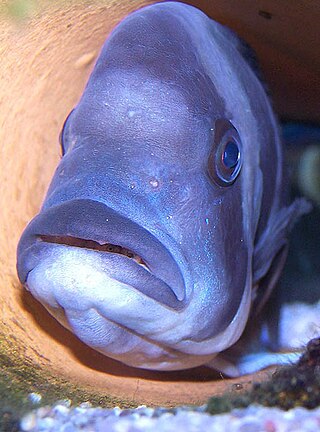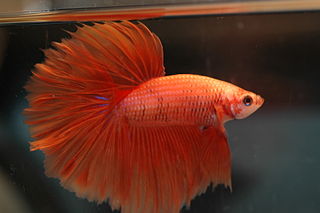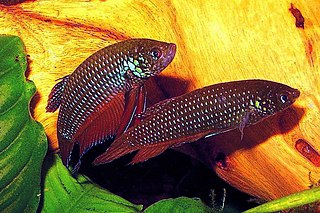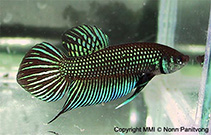
Mouthbrooding, also known as oral incubation and buccal incubation, is the care given by some groups of animals to their offspring by holding them in the mouth of the parent for extended periods of time. Although mouthbrooding is performed by a variety of different animals, such as the Darwin's frog, fish are by far the most diverse mouthbrooders. Mouthbrooding has evolved independently in several different families of fish.

Gouramis, or gouramies, are a group of freshwater anabantiform fish that comprise the family Osphronemidae. The fish are native to Asia—from the Indian Subcontinent to Southeast Asia and northeasterly towards Korea. The name "gourami", of Indonesian origin, is also used for fish of the families Helostomatidae and Anabantidae.

The Penang betta is a species of gourami native to Southeast Asia and common in swiftly flowing forest streams of the Malay Peninsula, Thailand, Sumatra, and the Riau Islands. In addition to its native range, the species has been introduced to Guam. It can be found amongst the vegetation growing along the banks. This species can reach a length of 6.7 centimetres (2.6 in) SL. It is one of the mouthbrooding Betta species. This species, as a natural predator of mosquito larvae, has found use in mosquito control efforts. Prior to its being eclipsed in Western public recognition by the mass-imported B. splendens, B. pugnax was well known as a fighting fish, as denoted by the specific epithet of pugnax, attracting the interest of scientists studying animal behaviour at least as long ago as the 1880s.

The Siamese fighting fish, commonly known as the betta, is a freshwater fish native to Southeast Asia, namely Cambodia, Laos, Myanmar, Malaysia, Indonesia, Thailand, and Vietnam. It is one of 73 species of the genus Betta, but the only one eponymously called "betta", owing to its global popularity as a pet; Betta splendens are among the most popular aquarium fish in the world, due to their diverse and colorful morphology and relatively low maintenance.

Bubble nests, also called foam nests, are created by some fish and frog species as floating masses of bubbles blown with an oral secretion, saliva bubbles, and occasionally aquatic plants. Fish that build and guard bubble nests are known as aphrophils. Aphrophils include gouramis and the synbranchid eel Monopterus alba in Asia, Microctenopoma (Anabantidae), Polycentropsis (Nandidae), and Hepsetus odoe in Africa, and callichthyines and the electric eel in South America. Most, if not all, fish that construct floating bubble nests live in tropical, oxygen-depleted standing waters. Osphronemidae, containing the Bettas and Gouramies, are the most commonly recognized family of bubble nest makers, though some members of that family mouthbrood instead. The nests are constructed as a place for fertilized eggs to be deposited while incubating and guarded by one or both parents until the fry hatch.
The spotted betta or Java fighting fish is a species of gourami endemic to Indonesia where it inhabits relatively cool, 22‒25 °C (72‒75 °F), highland streams of Java. In 1967, D. S. Johnson reported the species to be common in blackwaters of southern Malaya.

The Krabi mouth-brooding betta, Betta simplex, is a species of gourami endemic to Krabi Province, Thailand. It inhabits karst springs and wetlands, where it lives amongst vegetation close to the banks. This species can reach a length of 8 cm (3 in). This species can also be found in the aquarium trade and is taken from the wild for this purpose. The International Union for Conservation of Nature has assessed it as being "critically endangered" due to over-exploitation and the degradation of its restricted habitat by pollution and development of the surrounding land for farming.

Betta smaragdina, commonly known as the emerald green betta, blue betta or Mekong fighting fish is a species of gourami native to Southeast Asia. The species gets its green and blue colors due to refraction and interference of light that results from hexagonal crystals that are less than 0.5 micrometres. It is found in the aquarium trade.

The peaceful betta or crescent betta is a species of gourami native to Southeast Asia.

Betta is a large genus of small, active, often colorful, freshwater ray-finned fishes, in the gourami family (Osphronemidae). The best known Betta species is B. splendens, commonly known as the Siamese fighting fish and often kept as an aquarium pet.

Betta edithae is a species of gourami endemic to Indonesia where it occurs in Kalimantan, Sumatra and the Riau Archipelago. This species grows to a length of 8.2 cm (3.2 in), and can be found in the aquarium trade. The specific name honours the German aquarist Edith Korthaus (1923-1987), who co-discovered this species with her husband Walter Foersch. Walter is honoured in the specific name of another species they discovered, Betta foerschi.

Betta mahachaiensis is a species of bubble-nesting betta native to Thailand, where it occurs naturally near the Gulf of Thailand. It is typically seen in stagnant waters in swamps, pools, and ponds. The species can be found in brackish waters, with salinity levels between 1.1 and 10.6 parts per thousand. Betta mahachaiensis is capable of living in both fresh water and brackish water, a trait unique among fish in the genus Betta. This species grows to a length of 5 to 6 cm. It is found in the aquarium trade.
Betta obscura is a species of gourami that occurs in the Barito basin in Kalimantan Tengah, Indonesia. This species is a mouthbrooder, and grows to a length of around 9 centimetres (3.5 in) SL.
Betta compuncta is a species of ray-finned fish in the family Osphronemidae. It reaches 6.2 cm in standard length.
Betta midas is a species of gourami in the genus Betta. It is native to Asia, specifically the island of Borneo, where it occurs in the Kapuas River basin in West Kalimantan in Indonesia, as well as western Sarawak in Malaysia. It is typically found in acidic blackwater rivers in remnant and intact peat swamp forests. The species reaches 6.6 cm in standard length and is known to be a facultative air-breather.
Betta pardalotos is a species of fish in the family Osphronemidae. It is native to Asia, where it occurs in the Musi River basin on the island of Sumatra in Indonesia. The species reaches 7.2 cm in standard length and is known to be a facultative air-breather. It feeds on insects and other small invertebrates such as zooplankton.

Betta fusca, commonly known as the dusky betta, is a species of gourami. It is a freshwater fish native to Asia, where it occurs on the island of Sumatra in Indonesia. The species reaches 8.2 cm in total length and is known to be a mouthbrooder and a facultative air-breather.
Betta siamorientalis is a species of gourami. It is a freshwater fish native to Asia, where it occurs in shallow marshes, grass fields, and paddy fields in Thailand and Cambodia. It is typically found in still, vegetated environments at the water's edge and is known to use aquatic plants as shelter for building and guarding bubble nests. It is known to occur alongside the species Anabas testudineus, Lepidocephalichthys hasselti, Macrognathus siamensis, Monopterus albus, Pangio anguillaris, Trichopodus trichopterus, Trichopsis pumila, Trichopsis schalleri, and Trichopsis vittata. The species reaches 3.6 cm in standard length and is known to be a facultative air-breather.
Betta patoti, sometimes known as the tiger betta or zebra betta, is a species of gourami. It is a freshwater fish native to Asia, where it occurs in the southern part of East Kalimantan on the island of Borneo in Indonesia. The species reaches 10.7 cm in total length and is known to be a facultative air-breather.
Betta renata is a species of gourami. It is native to Asia, where it occurs in blackwater rivers in the vicinity of peat swamp forests on the island of Sumatra in Indonesia. The environments in which the species occurs are characterized by acidic water with a pH of 4.1, as well as abundant plant debris and logs. The species reaches 8.5 cm in standard length and is known to be a facultative air-breather.











